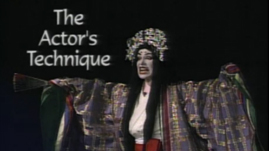Teachers' Domain - Digital Media for the Classroom and Professional Development
User: Preview



Shozo Sato describes Kabuki acting technique and the training that Kabuki performers, traditionally all male, go through in order to learn how to play male, female, young, and old characters. He demonstrates vocal inflections and actual movements—walking, how the head is held, poses—of various Kabuki characters, including the differences between male and female characters. He also demonstrates the transformation of a female character from her teens to her 30s.
Find additional arts resources for your classroom at the KET Arts Toolkit website.
In the early 1600s, while Elizabethan drama revolutionized English theater, another groundbreaking form of theater was captivating audiences in the Far East. Kabuki theater, a spectacular blend of singing, dancing, and acting, emerged in Japan at the beginning of the Edo Period (about 1603).
During this peaceful period, Japan experienced prolonged economic security, which gave rise to an affluent and visible merchant class (the chounin). Chounin audiences, newly wealthy and hungry for entertainment, considered Kabuki theater to be an appealing alternative to traditional Noh theater, an understated and aristocratic theatrical experience using dance and masks. Though Kabuki theater borrowed many elements from the Noh tradition, it cast off the elegance and refinement of Noh theater in favor of lavishness and exaggeration. From the start, the ruling Tokugawa government believed Kabuki was a corrupting influence that encouraged the intermingling of classes and made many attempts over the years to control its influence.
Kabuki literally means “sing, dance, skill.” A shrine dancer named Okuni is credited with giving birth to Kabuki by performing a series of dances in a dry riverbed in Kyoto. Early Kabuki (Onna Kabuki) consisted mainly of dance performances done by women. In 1629, the governing officials deemed these dances a threat to public morals and prohibited women from performing in Kabuki. Following the edict, young men’s Kabuki (Wakushu Kabuki) became popular, but it too was outlawed.
When women and young boys were banned from Kabuki, males took on all the roles including the female roles. Actors create characters not by expressing feelings, but through movement, dancing, and vocal expression. Kabuki actors train for years to develop a deep vocabulary of movement and vocal coloration in order to play the many stock characters that populate Kabuki dramas. Roles are divided into general types such as loyal and courageous men, villains, young mild men, comic roles, and children. Each character type calls for a prescribed type of movement and vocal quality.
 Loading Standards
Loading Standards